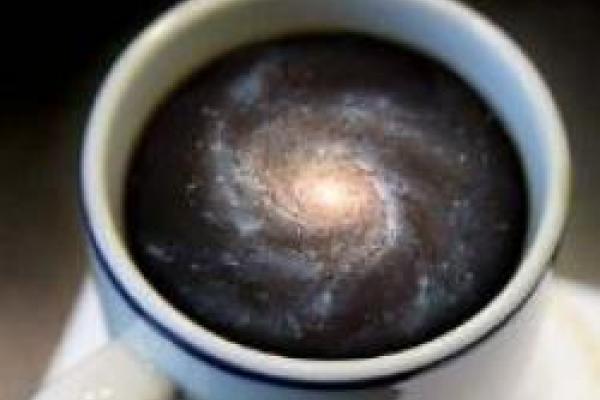Coffee Makes the Collaboration Go Further

At 10:25 am on the fourth floor of McPherson at The Ohio State University, the last few collared shirts—both Hawaiian and polo—struggle to hold their bikes or laptops in one hand, while fumbling office keys in the other. Quickly scooping up their mugs adorned with famous physicists, they rush to the kitchen to get to the thermos labeled “Dark Matter (the strong stuff)” before a second batch must be brewed.
By 10:35, the OSU Astronomy Department’s daily “Morning Coffee” is in full swing. Expert faculty enthusiastically discuss—with both disdain and admiration—recent astronomical studies from around the world.
Casual, yet professional, discussion of astronomical studies is common at many universities and research centers, but the daily dose of coffee and enthusiasm at Ohio State is one of a kind. When considering the OSU Astronomy Department’s specialized faculty encourages the participation of graduate and undergraduate students during these daily discussions, Morning Coffee is truly unique to Columbus, Ohio.
In the often stuffy and formal academic environment, an impenetrable barrier commonly exists between students and their professors. However, in the Astronomy Department at OSU, it is ordinary to overhear an open-door discussion between a theoretical cosmologist and a curious business major, who unexpectedly share a common motivation to understand the Universe they live in.
This unanimous desire to understand the universe is obvious on the fourth floor. The offices are a second home to experts in many specific and diverse and complex astronomical fields, including stellar evolution, star formation, gravitational microlensing, instrumentation, cosmology, and active galactic nuclei—just to name a few. Through department meetings like Morning Coffee, the collaboration between diverse faculty and students often gives researchers a valuable new perspective on current and future research projects.
There are many departmental meetings which encourage this informal collaboration, such as Active Galactic Nuclei (AGN) Lunch on Wednesdays, the weekly Colloquium Series on Thursday afternoons, and Journal Club on Fridays. However, the academic cooperation extends beyond the astronomy department halls at Ohio State.
Each Friday afternoon many of the astronomy faculty make a short trek across the street to the Physics Research Building (PRB) to hear research talks hosted by the multi-disciplined Center for Cosmology and Astro-Partical Physics (CCAPP).
The accessibility and expertise of the faculty is not the only unique aspect of the Astronomy Department. Unlike many other prestigious graduate programs who limit research to a student’s last few years of graduate education, Ohio State is known for immediately immersing graduate students in active astronomical research. From the start, Ohio State graduate students are given the responsibility of taking and analyzing complex astrophysical information and significantly contributing to numerous astronomical publications.
Specializing in both observational and theoretical astrophysics, graduate students at OSU commonly co-author ten or more refereed journal articles while pursuing their doctorate. By contributing to so many research projects—as well as attending conferences, going on observing runs, and giving numerous research talks—OSU graduate students acquire knowledge and skills covering a broad range of astronomical fields that are truly unparalleled.
In addition to the responsibilities of talented graduate student researchers, undergraduate astronomy and physics majors also provide valuable contributions to faculty research. Throughout the department, it is clear the professors are enthusiastically motivated to both learn and teach. The majority encourage undergraduates to explore astronomical interests by employing students as research assistants.
In the astronomy department halls at Ohio State, undergraduates have an easy time finding as much professional research work as their schedule (willingly) allows. While courses are not occupying student time, the astronomy department runs the Summer Undergraduate Research Program (SURP). Through SURP, students are employed full-time by the Astronomy Department working on professional astronomical research. It is even more impressive that a number of SURP participants co-author published research articles concerning their summer project during the following school year.
With so many talented student researchers eager to gather and analyze astronomical data, it is fortunate OSU has the resources to gather its own data. Through partnerships with other research institutions (both national and international), OSU owns partial shares to a number of world-class observatories.

The most notable of these is the Large Binocular Telescope (LBT) located on Mount Graham in Southern Arizona. Consisting of two 8.4-meter telescope mirrors (which gather about 24 times more light than the Hubble Space Telescope) and housed in a revolving structure similar to the size of OSU’s mammoth Thompson Library, LBT is one of the most technologically advanced observatories in the world.
When considering busy faculty schedules with numerous observing opportunities, the OSU Astronomy Department is in a unique position to send not only graduate students, but also undergraduates on valuable observing runs. There are few universities that provide undergraduate students with the opportunity to spend two weeks single-handedly controlling a multi-million dollar Observatory atop Kitt Peak in Arizona. However, OSU does just that.
Whether between faculty, graduate students, or undergraduates, collaboration is the foundation of the OSU Astronomy Departments success. Under the often murky skies of Columbus, Ohio, the fourth floor of McPherson Lab is abuzz with excitement and enthusiasm about unraveling the mysteries of our Universe.
Some of the questions being addressed have existed for thousands of years, and definitive progress is not being made because of the individual intellectual giants at OSU, but because of their ability to work both individually and as a team. After all, where else would you find a group of experts that is so unconcerned with credit they opt to publish a research paper co-authored by M. Coffee?
